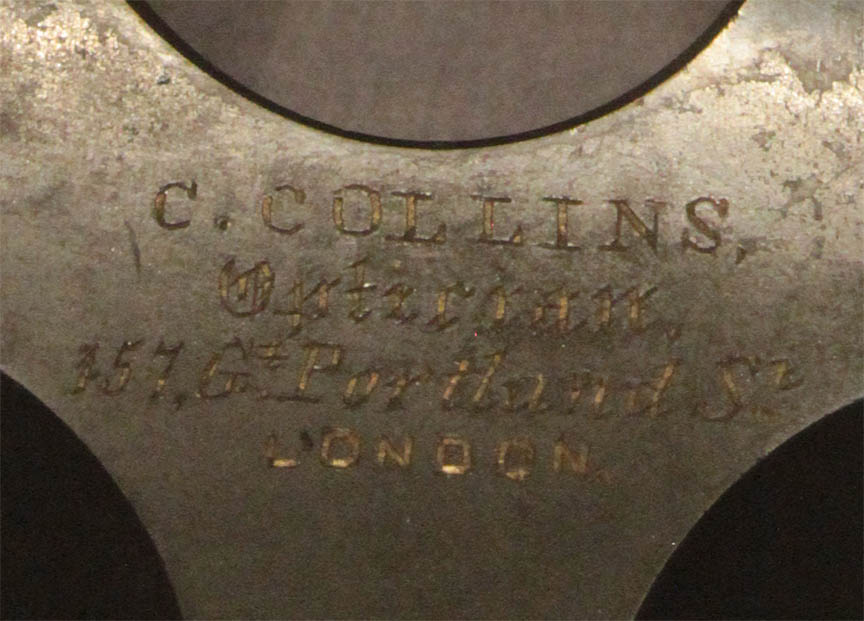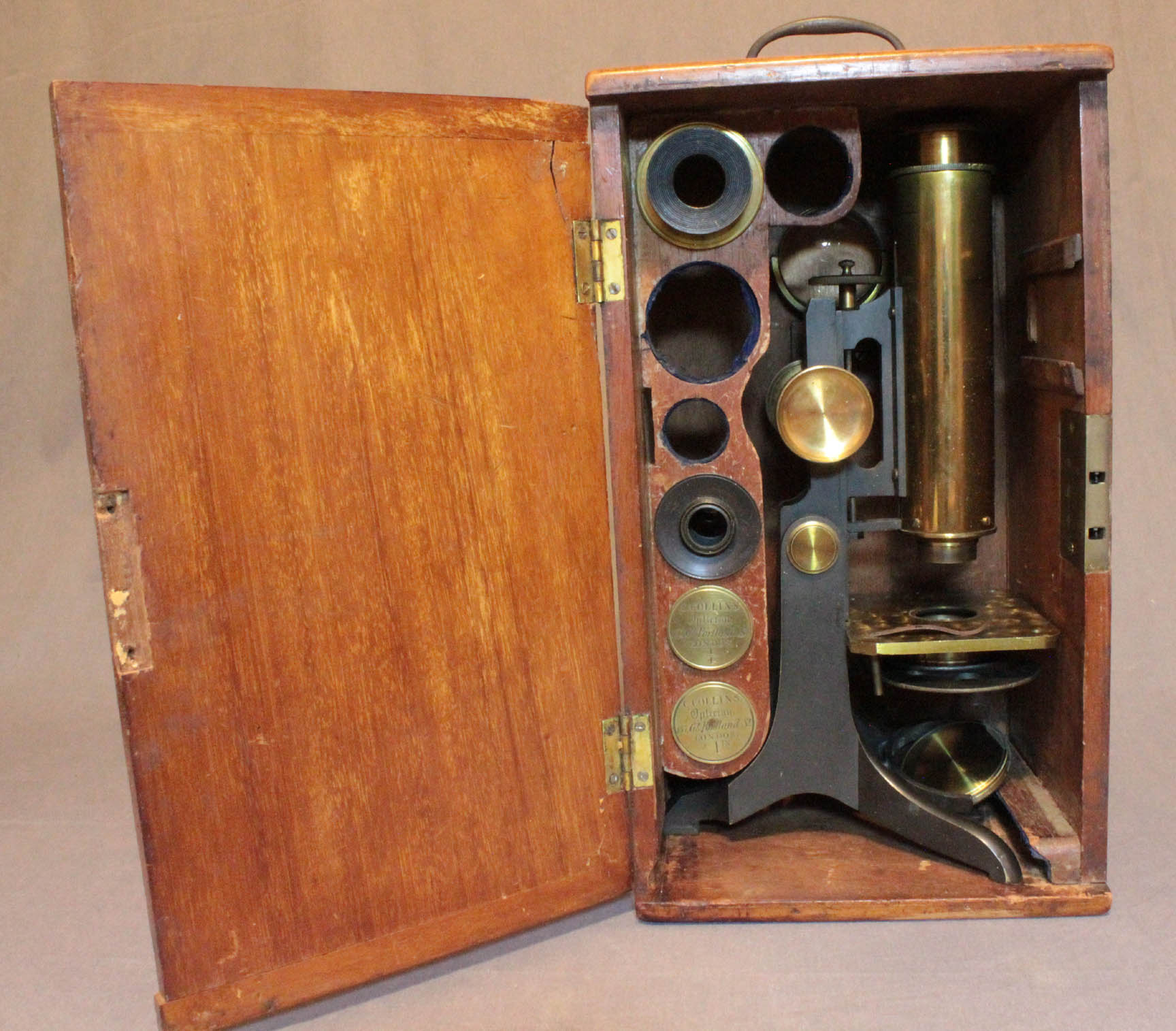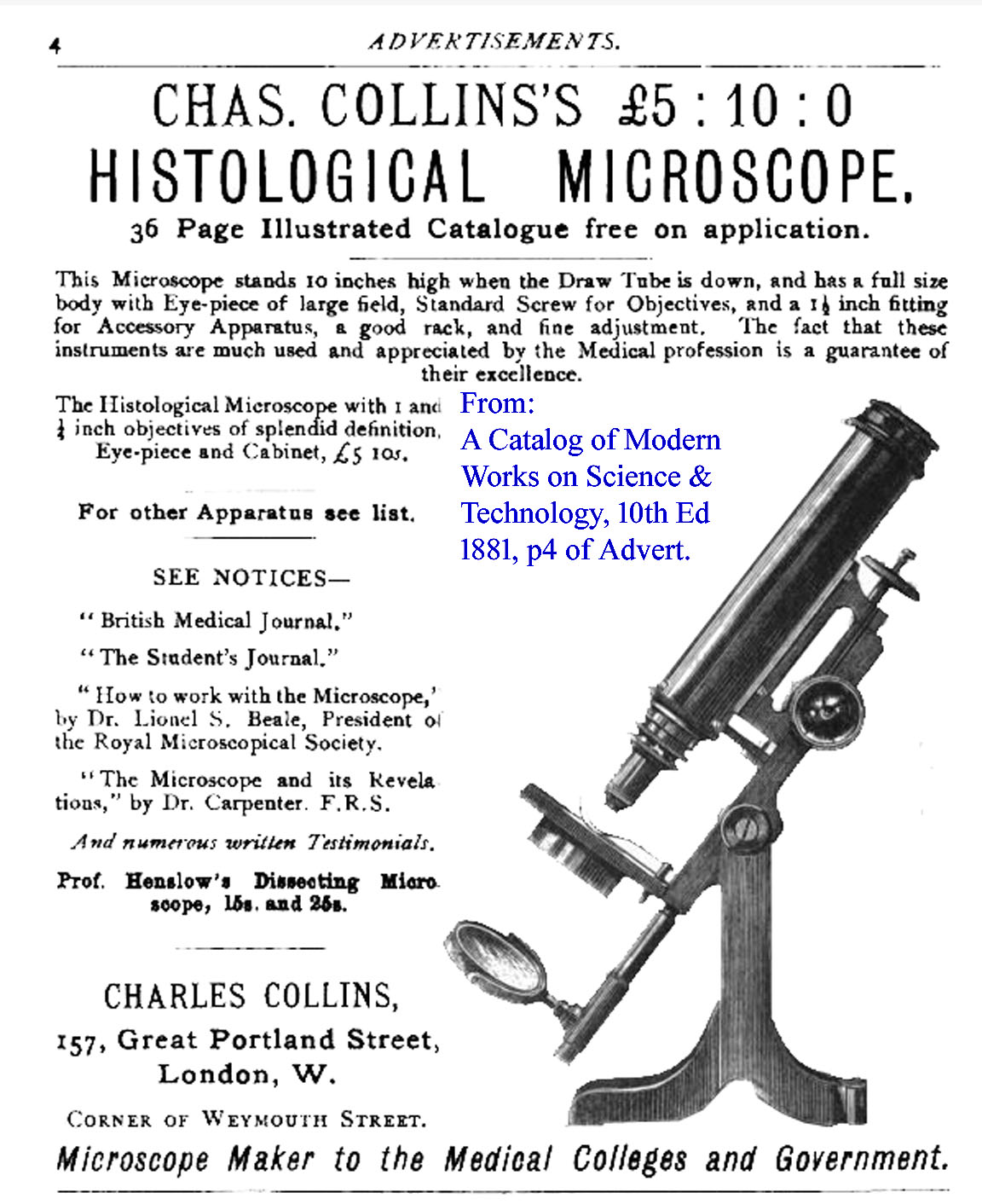THE HISTOLOGICAL STUDENT'S MICROSCOPE
C. COLLINS, Optician, 151 Portland St, LONDON
Please Click On Any Picture for a Larger Version
| DESCRIPTION | HISTORY |
 This moderate sized compound monocular microscope stands about 12 inches (305 mm) in a working inclined position. It arises from a
This moderate sized compound monocular microscope stands about 12 inches (305 mm) in a working inclined position. It arises from a claw-Ytype foot with the trunnion inclination joint axis of rotation about 4.5 inches from the surface of the table. The tailpiece is a brass rod which is an extension of the limb below the stage supporting a blackened tubing about 2 inches in length that carries the gimbal holding the concave mirror on a stem. The stage has a decorative surface with a hole near each of its four corners to support accessories such as the stage-mounted bullseye condenser that is included. Removeable stage clips fit into the holes. On the bottom of the stage is a ring to accept substage accessories, with a wheel of apertures currently in place. The limb supports a blackened support the the tube which is moved up or down by the coarse focus knob via straight rack and pinion. The tube support is hollowed out in its center. A thin rod passes through the tube support and is fixed to a thin block of metal which sits under the nosepiece fine focus lever. The top of this rod is threaded. When the fine focus knob is tightened, it pulls the rod attached to the small block under the fine focus lever upward. The nosepiece is sprung so that when the knob is turned in a counterclockwise direction, the nosepiece is pushed downward by the spring inside the nosepiece. Although short lever fine focus mechanisms were common. especially earlier in the nineteenth century, this unusual way of controlling it from the top of the limb was apparently unique to Collins.
 In addition to the stage-mounting bullseye condenser, include two eyepieces and two objectives. One eyepiece is missing the top element. The objectives are a 1 inch and a ¼ inch. Both come in original signed Collins cans.
There is also a substage polarizer mount but it lacks the prism.
A wheel of apertures fitting the microscope is present. The original case is present, though has some cracks and repairs.
In addition to the stage-mounting bullseye condenser, include two eyepieces and two objectives. One eyepiece is missing the top element. The objectives are a 1 inch and a ¼ inch. Both come in original signed Collins cans.
There is also a substage polarizer mount but it lacks the prism.
A wheel of apertures fitting the microscope is present. The original case is present, though has some cracks and repairs.
 Charles Collins was in business from about 1863 to about 1915, though by the latter date microscopes had become a less prominent part of his business. Sometime in the early 20th century, the business was no longer flourishing. He initially made bar-limb microscopes, but changed to a Lister-limb designs sometime in the 1870s. The first microscope that Collins called his
Charles Collins was in business from about 1863 to about 1915, though by the latter date microscopes had become a less prominent part of his business. Sometime in the early 20th century, the business was no longer flourishing. He initially made bar-limb microscopes, but changed to a Lister-limb designs sometime in the 1870s. The first microscope that Collins called his StudentModel was a Bar-Limb introduced about 1867 and available as both monocular and binocular. By 1880 he advertised the model featured on this page as his
Studentmodel and it was also referred to as the
Histologicalmodel. It was heavily advertised during the 1880-1890 period and these models are not uncommonly seen for sale nowadays. They feature his modified English foot, and hollowed out tube support, as well as a large diameter optical tube so that it could use all the eyepieces that Collins' firm produced for his larger models. In the 1881 catalog, he offered three slightly different variations; the option of a larger foot, the standard version seen above, and also the option to have a sliding tube coarse focus instead of rack and pinion. He stated they were all available for the same price(?). Collins made reasonably qood quality equipment and his optics were also good, though perhaps not as fine as some of the top opticians like Powell & Lealand or Tolles. For a detailed review of Collins and his work, please see the excellent review by Brian Stevenson on his website, microscopist.net. Collins marketed accessories and an example of his slide preparation kit is on this site.